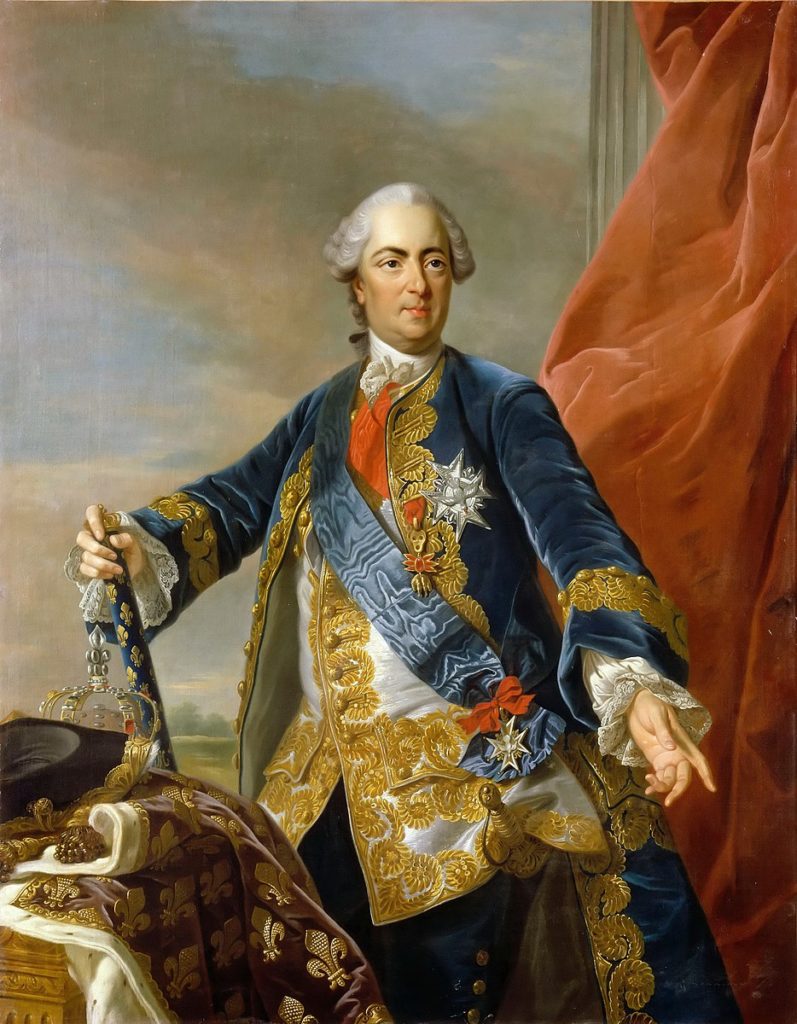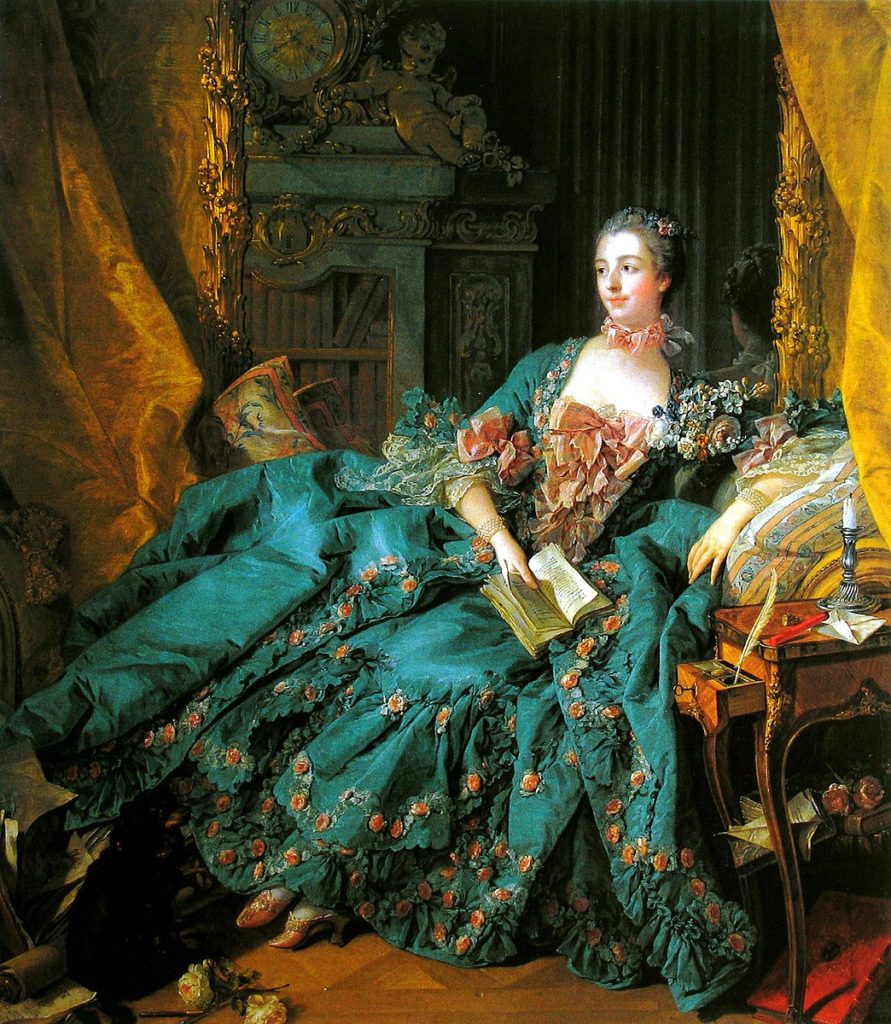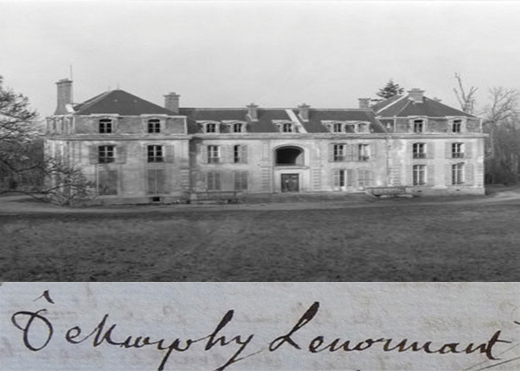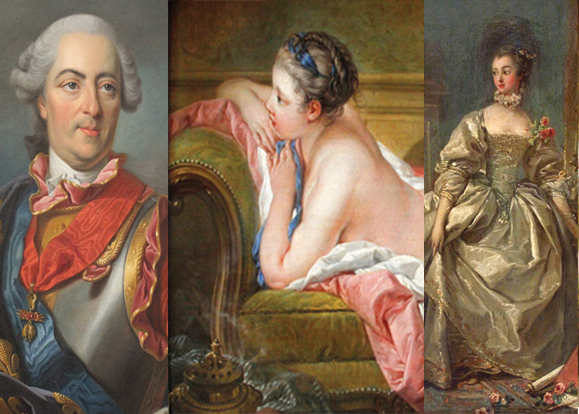a.k.a. Marie-Louise O’Murphy de Boisfailly, Morphy, Morphi, Mademoiselle de Murph, La Belle Morphise, Louison, Madame la Countess de Beaufranchet d’Ayat, Mme Lenormand de la Gravière Flaghac, O’Murphy Lenormand, Mme Dumont, “Murphy,” and…
Our Lady of the Potatoes
En quels terms en êtes-vous avec la vielle coquette? In English: What terms are you on with the old flirt? In Mean Girl: “Are you still having sex with that old lady?” So asked the brazen 15-year-old mistress of King Louis XV of France, one Marie-Louise O’Murphy. The question was a tactical blunder since “la vielle coquette” was the all-powerful Madame de Pompadour, who ran France for the lazy Louis and wasn’t about to be overthrown by this Irish upstart. The king, too, was horrified by the question: red-faced, the sputtering monarch jumped up and down, then ran from the room. Within a few weeks Marie-Louise was given what could only be called the bum’s rush out of Versailles.
When the Irish Jacobite army failed to put Catholic King James II on the throne, many of its soldiers fled to France, where they lived in a demimonde known as L’Irlandais. They were a population of misfits speaking a mishmash of English, Irish, and French. Two members of this odd diaspora were Daniel O’Murphy and Peggy Hickey, who met and married in Rouen. Daniel was a soldier-turned-cobbler-turned-blackmailer, and Peggy a camp-follower and a scavenger so outrageous she had scoured battlefields relieving dead soldiers of their teeth.
The O’Murphy family conflated Irish superstition with Catholicism and folk magic, and they had good reason to be wary: their first seven children had died of smallpox, a scourge still raging. They festooned their home with religious images, shrines to dead relatives, holy water fonts, saint statues, and every manner of good luck charm, including a wine bottle filled with the blood of a black cat. Rabbits’ feet were entwined with rosary beads, and everywhere, candles burned all the time. Finally, in 1724, Mrs. O’Murphy bore a child that survived. All credit was given to the Blessed Virgin Mary, and the five girls who followed all had names that began with Marie. She named her last daughter Marie-Louise.

In 1737, as soon as Marie-Louise was born, Daniel, for good luck, spat in the baby’s face. But Peggy did something she had never done with her other daughters: she carried the newborn up the stairs to ensure Marie-Louise would “rise in the world.” The mother proved prescient: Marie-Louise did rise – from abject poverty and a disreputable family to become the darling of Versailles and mistress to King Louis XV. Three marriages, children, and a great fortune – made by her savvy investments in the Ferme Générale, a royal Ponzi scheme too French to explain – followed. Her formidable rise began with a picture, a very nude, very provocative portrait of Marie-Louise by famed artist, François Boucher. She was 13 at the time.
In their wretched slum, the O’Murphy family distinguished themselves by being more déshabille – okay, shanty – than their wretched neighbors. As unsavory as they were, the O’Murphys were close and loving, given to frequent hugs and kisses. Mrs. O’Murphy was a curious character, a devout Catholic who never missed mass, but a prostitute and pickpocket who served time in la prison for soliciting. Even more curious, her Irish DNA was without the gene for shame and apparently never felt a morsel of remorse.
Mr. O’Murphy, too, was an ex-con, having been holed up in the Bastille for burglary and blackmail. No matter his history, in 1747, the Banshee took it upon themselves to cross the Irish Sea and wail outside the window of Daniel O’Murphy, doubtless a tribute to his service in the Irish Regiment. Within two days, he died in the arms of his loving wife and daughters.
After a respectable (and loud) period of keening, Peggy pulled herself together and decided her pretty girls were the way out of poverty. Always something of a stage mother, she had, since their early childhood, been primping her daughters with mud facials, makeshift nose jobs, and dimple tools. They headed off to Paris, the eldest girls already tarted up in rouge, powder, and ratty furs, saving Marie-Brigitte, scarred by smallpox. Marie-Louise, holding the family pig, was lost in daydreams.
It didn’t take long for the O’Murphy girls, working as both prostitutes and actresses, to attract aristocrats and soldiers alike. The Prefecture of Police disliked them immediately, sarcastically noted their “campaigns” following the French Army; he even managed to condemn the family wallflower, Marie-Brigitte, “despite her ugliness we are sure that she wasn’t an innocent girl.” Actually, she was, as was Marie-Louise – her virginity would increase her value in the marketplace.
The original Casanova, Casanova was lolling around the apartment of Marie-Louise’s sister when he saw a ragamuffin he later described as “a pretty, ragged, dirty little creature of thirteen.” The legendary satyr brings Marie-Louise to his friend and fellow connoisseur of young female flesh, the artist Françoise Boucher, who immediately begins to paint her portrait. The famous nude was titled, alternately, “Blonde Odalisque,” “Resting Girl,” or “Mlle O’Murphy,” and a copy found its way to King Louis XV.

The King had inherited the insatiable sexual appetite of the Bourbons and even enlisted his staff as de facto pimps to scour Paris for young girls. But when he saw the nude portrait of Marie-Louise, it was ooh-la-la and let me see her in person. As soon as he did, he sent his lawyer to negotiate with Peggy O’Murphy, who demanded (and got) a fortune for the services of her youngest daughter.
The next step was the most important: Marie-Louise had to be examined by the king’s official mistress or maîtresse-en-titre – Chief of Staff would be a more accurate title – Madame de Pompadour. The all-powerful Pompadour, both brilliant and vindictive, ruled France for the lazy king taking charge of all his affairs and all his paramours. It should be noted that Louis also had a wife, Polish princess Marie Leszczyńska, and 11 children. It should also be noted that he refrained from sexual relations with both his wife and mistress.

Marie-Louise met with Pompadour’s (begrudging) approval and was installed in Versailles as the petite maîtresse known as “Morphy.” The palace gossip Marquis D’Argenson wrote in his diary at the time: “The King has a new mistress . . . she belonged to a family of prostitutes and thieves.” While that was certainly the truth, it didn’t matter because Morphy charmed everyone, she was unsophisticated, unspoiled, and good-humored. Her popularity distressed Pompadour, who had her transferred from Versailles to Parc-aux-Cerfs (which translates, ironically, to Stag’s Park), a residence near the castle (but away from the action), where the king kept his other petite maîtresses.
Marie-Louise had a retinue of footmen, hairdressers, maids, and closets of gowns, and she, who used to bathe every six months, now took two baths a day, one of them in milk. Amidst all the luxury and decadence, she kept the O’Murphy tradition of growing potatoes (or as they would say in Ireland, “murphies”) in pots by the window and later cooking them in the fireplace. After all, the skin is the best part.
King Louis XV and Marie-Louise O’Murphy developed an affectionate relationship. Despite (or perhaps because of) the 27-year age difference, she was his favorite in the Parc-aux-Cerf. The monarch even adapted some of her Irish superstitions: when he yawned, he now crossed himself “to stop the devil from jumping inside.” (Too late, his subjects could claim, the devil was already dancing inside.) He was delighted to learn she was pregnant, but as soon as the baby, a girl, was born, she was taken away from her mother.
When Marie-Louise, heartbroken, learned why her child was taken from her, “no child of the King could grow up in a brothel,” she became bitter and blamed Pompadour. Sensing the grief of the petite maîtresse, the many enemies of the maîtresse-en-titre moved in, feeding Marie-Louise’s ambition, convincing her she could be the royal favorite. So emboldened, the young girl asked the king that indelicate question about his sex life with Pompadour and used the deadly V-word – “Vielle.” Her days at Versailles were over.
The Palace, to keep her from gossiping about its intrigue, gave Marie-Louise a generous settlement, an 18th-century NDA, an order never to return or contact the king. Pompadour even arranged a marriage for the discarded girl: Her new husband was Jacques de Beaufranchet, a young officer from a noble but impoverished family in Auvergne. Marie-Louise O’Murphy was now Madame la Countess de Beaufranchet d’Ayat. But the d’Ayat chateau was shabby, she missed the Palace, and she missed the king. Jacques went off to fight in the Seven Years War and was killed in the Battle of Rossbach just weeks before Marie-Louise gave birth to their son and had the bad taste to name him Louis.
In 1757 Marie-Louise married again, this time to an older financier, Comte de Flaghac, a greedy and bilious burgher who, paradoxically, married the beautiful widow for her money. At this point in her lively life, she was only 21. The marriage was miserable, but it brought Marie-Louise both a daughter, Marguerite, and savvy in the world of investment. It also brought her to the Abbé Terray, who, while nominally a priest, was France’s Controller-General of Finance and a man with many mistresses.

Terray, to quote Oscar Wilde, possessed “the remains of a remarkable ugliness,” but in some Kissingeresque way, women found him attractive. Marie-Louise and the Abbé began a long-term affair that was as financial as it was sexual (many believed he was Marguerite’s actual father). Terray, essentially a tax collector, gave Marie-Louise access to investments, where she made and re-invested vast sums – she singlehandedly built a fortune. As much as Auvergne had become her home, she bought a house in Paris after her husband and Terray died. Marie-Louise, still beautiful and looking younger than her years, became a merry widow of the Paris social scene.

She made a great effort to get an army commission for her son Louis and claimed, with a straight face, the House of O’Murphy was “one of the most noble families in Ireland.” She managed to produce a coat of arms and ancestral documents tracing her lineage back 400 years; finally, she actually bought a noble title, even throwing one in for Marie-Brigitte. Of course, that title (and her money, lands, chateaus and, and …) made her a bejeweled target when Le Deluge poured down on France.
Marie-Louise didn’t see the French Revolution and Reign of Terror coming, but she still had her Rouen street smarts. She hid her money and valuables, chopped off her hair, dressed in the uniform of a citoyenne, and kept protesting to anyone and everyone, “Je suis Irlandais, Je suis Irlandais!” Her name, she insisted, was simply “Murphy.”

But the revolutionary army wasn’t buying the Irlandais defense and arrested Murphy; now it was her turn to be sentenced to the guillotine. Her rat-infested cell had an excellent view of the rolling bloody heads, and for months she watched the scenery and waited. But her son rallied the residents of Auvergne to make a miracle for their Marie-Louise: they presented the government with a petition testifying to her goodness, great generosity, and loving spirit. She was released.
Marie-Louise may have kept her head during the Terror, but she lost it soon after when she met Monsieur Louis-Phillipe Dumont, a handsome boulevardier some 28 years her junior. At her insistence, they courted only in the evening and only by candlelight. In 1795, they married. But after three years Mme Dumont gave her husband le boot when she realized he had been sniffing around her fortune. She held on to it during the Revolution and wasn’t going to lose it to some bedroom-eyed rake – she was, after all, the daughter of Mrs. Peggy O’Murphy.
She outlived all her contemporaries and died, at 77, in the home of her daughter Marguerite, now a proper baroness. A smattering of ancient Irish / French nuns joined Marguerite in the vigil over Marie-Louise’s body. Marguerite noticed the nuns passing a piece of paper and asked what it was. They showed her and she saw, for the first time, the Boucher painting of her mother at 13. Souer Concordia O’Brien asked the group, “Now wasn’t she a lovely, lovely girl?” They all agreed she was. ♦


Ms. Rogers & IA, I’ll look forward to reading this. I knew of La Petite Murphy but perhaps you will give me some facts new to me. Great job to whoever provided the photos. You might see my article on Irish Central about Patrick McMahon, the Irishman who became President of France. The irrepressible Irish – quite a miracle – still are.
US’nEire
This whole daring romance between King Louis XV and Marie-Louise O’Murphy occurred long before Dr. Richard von Krafft-Ebing conceptualized pedophilia and long before men-hating pseudo-feminists were seeking to pervert-shame men for whatever reason no matter how minute it was. Therefore, when they became an item, they didn’t have to listen to all the pedophile-panic propaganda whenever anyone may have expressed disapproval of their relationship. At the same time, it was kind of sad that King Louis XV’s wife, Marie Leszczyńska, had to sit by and watch a beautiful young girl trample on her marriage. In that sense, it was probably better that the relationship between King Louis XV and Marie-Louise O’Murphy came to an end. Who can really say? Anyhow, good article! 🙂